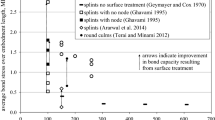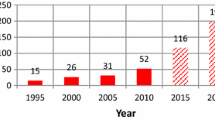Abstract
Southern pine (Pinus spp.) trees are increasingly grown on intensively managed plantation forests that yield excellent growth. Lumber cut from these trees often contains a large percentage of juvenile wood which can negatively impact the strength and stiffness. This study was undertaken to assess the bending strength and stiffness properties of No. 2 grade lumber in the 2 × 6 (n = 86), 2 × 8 (n = 112), 2 × 10 (n = 87), and 2 × 12 (n = 53) sizes collected across the geographical range. In total 338 pieces were collected and tested. All material was re-graded as No. 2 (on-grade) prior to testing to confirm the grade. The lumber was tested in four-point bending according to ASTM D198. The study suggests that as lumber size (width) increases (2 × 6, 2 × 8, 2 × 10, and 2 × 12) the stiffness (MOE15) increases (10.1, 10.3, 11.0, 11.8 GPA, respectively). The bending strength (Fb) values for 2 × 6, 2 × 8, 2 × 10, and 2 × 12 lumber were 8.8, 8.2, 5.1, and 8.1 MPa, respectively. Overall lumber graded as No. 2 because of wane and skip had the largest stiffness, strength, and specific gravity compared to lumber graded as No. 2 due to other factors such as knots. No. 2 Prime lumber was significantly less stiff (8.5 vs. 10.9 GPa), less strong (28.3 vs. 42.1 MPa), and had lower specific gravity (0.44 vs. 0.49) than No. 2 lumber (Common). Lumber with pith was generally less stiff and strong in the 2 × 6 and 2 × 8 sizes but in 2 × 10 and 2 × 12 lumber there were no significant differences compared to lumber without pith.



Similar content being viewed by others
References
AFPA (2005) National design specification (NSD) for wood construction with commentary and supplement: design values for wood construction, 2005th edn. American Forest and Paper Association, Washington
ALSC (2013) American Lumber Standard Committee Board of Review: Board of Review Minutes. February 1, 2013. American Lumber Standards Committee, Germantown, MD
ALSC (2014) Grading machines approved by the board of review. American Lumber Standards Committee, Germantown
ASTM D198 (2014) Standard test methods of static tests of lumber in structural sizes. ASTM International West Conshohocken, PA
ASTM D1990 (2014) Standard practice for establishing allowable properties for visually-graded dimension lumber from in-grade tests of full-size specimens. ASTM International West Conshohocken, PA
ASTM D245 (2006) Standard practice for establishing structural grades and related allowable properties for visually graded lumber. ASTM International, West Conshohocken
ASTM D2915 (2010) Standard practice for evaluating allowable properties for grades of structural lumber. ASTM International West Conshohocken, PA
ASTM D4761 (2013) Standard test methods for mechanical properties of lumber and wood-base structural material. ASTM International, West Conshohocken
Bliss JC, Kelly EC, Abrams J, Bailey C, Dyer J (2010) Disintegration of the US industrial forest estate: dynamics, trajectories, and questions. Small scale For 9:53–66
Clark A III, Jordan L, Schimleck L, Daniels RF (2008) Effect of initial planting spacing on wood properties of unthinned loblolly pine at age 21. Forest Prod J 58(10):78–83
Dahlen J, Jones PD, Seale RD, Shmulsky R (2012) Bending strength and stiffness of in-grade Douglas-fir and southern pine No. 2 2 × 4 lumber. Can J For Res 42:858–867
Dahlen J, Jones PD, Seale RD, Shmulsky R (2013) Mill variation in bending strength and stiffness of in-grade southern pine No. 2 2 × 4 lumber. Wood Sci Technol 47(6):1153–1165
Dahlen J, Jones PD, Seale RD, Shmulsky R (2014) Sorting lumber by pith and its effect on stiffness and strength in southern pine No. 2 2 × 4 lumber. Wood Fiber Sci 46(2):186–194
de Mendiburu F (2014) Agricolae: Statistical Procedures for Agricultural Research. R package version 1.1-8. http://CRAN.R-project.org/package=agricolae. Accessed 1 Jun 2014
Evans JW, Kretschmann DE, Herian VL, Green DW (2001) Procedures for developing allowable properties for a single species under ASTM D1990 and computer programs useful for the calculations. USDA Forest Service. Forest Products Laboratory. FPL-GTR-126
Forest Products Laboratory (FPL) (2011) NONPAR: Nonparametric estimation program. http://www1.fpl.fs.fed.us/nonpar.html. Accessed 26 Sept 2011.
Fox J, Weisberg S (2011) An {R} Companion to applied regression, Second Edition. Thousand Oaks CA: Sage. http://socserv.socsci.mcmaster.ca/jfox/Books/Companion
Glass SV, Zelinka SL (2010) Moisture relations and physical properties of wood. Pages 4-1-4-19 In: RJ Ross (ed) Wood Handbook. USDA Forest Service. Forest Products Laboratory. FPL-GTR-190.
Graves S, Piepho HP, Selzer L, Dorai-Raj S (2012) multcompView: Visualizations of Paired Comparisons. R package version 0.1-5. http://CRAN.R-project.org/package=multcompView
Green DW, Shelley BE, Vokey HP (1989) In-grade testing of structural lumber. In: Proceedings of workshop sponsored by In-grade Testing Committee and Forest Products Society. Proceedings 47363. Madison, WI: Forest Products Society
Kretschmann DE (2010a) Mechanical properties of wood. Pages 5-1-5-46 In: RJ Ross (ed) Wood Handbook. US For Serv. Forest Products Laboratory. FPL-GTR-190.
Kretschmann DE (2010b) Stress grades and design properties for lumber, round timber, and ties. Pages 7-1-7-16 In: RJ Ross (ed) Wood Handbook. US For Serv. Forest Products Laboratory. FPL-GTR-190.
Larson PR, Kretschmann DE, Clark III A, Isebrands JG (2001) Formation and properties of juvenile wood in southern pines. US For Serv. Forest Products Laboratory. FPL-TR-129.
Ledford D, McTague JP, Twaddle A, Rakestraw J, Dahlen J (2014) Impact of age and site index on lumber quality of intensively managed stands. Southern Regional Extension Forestry (In Press)
Lengths Random (2000) Terms of the Trade, 4th edn. Random Lengths Publications, Inc., Eucgene 97401
Madsen B, Nielsen LF (1992) Structural behavior of timber. Timber Engineering Ltd., British Columbia
McAlister RH, Clark A III (1991) Effect of geographic location and seed source on the bending properties of juvenile and mature loblolly pine. Forest Prod J 41(9):39–42
Munsell JF, Fox TR (2010) An analysis of the feasibility for increasing woody biomass production from pine plantations in the southern United States. Biomass Bioenergy 34(2010):1631–1642
R Core Team (2014). R: A language and environment for statistical computing. R Foundation for Statistical Computing, Vienna, Austria. URL http://www.R-project.org/
RStudio (2014). RStudio: Integrated development environment for R (Version 0.98.201) (Computer software). Boston, MA. Retrieved April 17, 2014.
SFPA (2005) Industry statistics: annual production from 2000 to 2005 (White paper). Southern Forest Products Association
SPIB (2012) Determination of design values for visually graded southern pine dimension lumber. Southern Pine Inspection Bureau, Pensacola
SPIB (2014) Standard grading rules for southern pine lumber. Southern Pine Inspection Bureau Pensacola, FL
USDA Forest Service (1988) The South’s fourth forest; alternative for the future. US For Serv., Forest Resour Rept. 24. US Gov. Print. Office. Washington, pp 512
Vance ED, Maguire DA, Zalesney Jr. RS (2010) Research strategies for increasing productivity of intensively managed forest plantations. J Forestry 4:183–192.
Conflict of interest
The authors declare they have no conflict of interest.
Author information
Authors and Affiliations
Corresponding author
Rights and permissions
About this article
Cite this article
Dahlen, J., Jones, P.D., Seale, R.D. et al. Bending strength and stiffness of wide dimension southern pine No. 2 lumber. Eur. J. Wood Prod. 72, 759–768 (2014). https://doi.org/10.1007/s00107-014-0848-y
Received:
Published:
Issue Date:
DOI: https://doi.org/10.1007/s00107-014-0848-y




